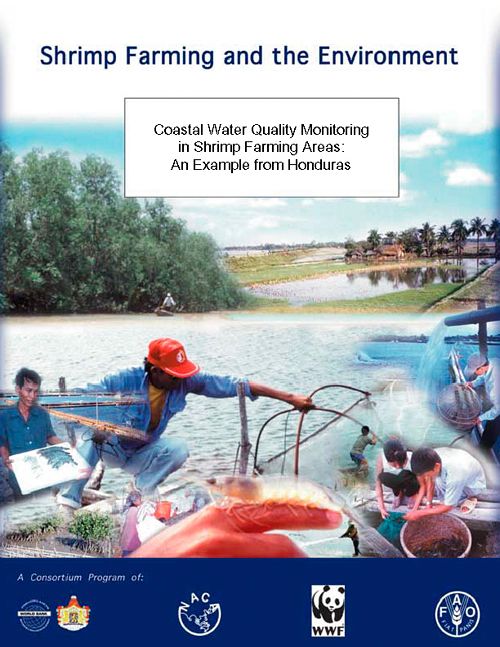Coastal water quality monitoring in shrimp farming areas: An example from Honduras
31 May 2005 | Claude E. Boyd and Bartholomew W. Green | 3410 Downloads | .pdf | 404.31 KB | Better management practices, Shrimp, Environment and Sustainability, Water quality
Various substances in shrimp farm ponds can contaminate waters, including nutrients (nitrogen and phosphorus), metabolic wastes, antibiotics, or other medicines to protect shrimp, and suspended soil particles from erosion. This report discusses ways to monitor these aspects of water quality, which is important from two standpoints for shrimp farmers. Incoming water used top supply shrimp ponds must be healthful and free of toxins to protect the growing shrimp, and effluent must be clean enough to avoid harming aquatic ecosystems downstream, and in many places to meet water quality standards.
The requirements and costs of setting up and operating a water quality analysis lab are provided, and the report describes methods of sampling and analysing water samples. Key aspects of lab operations, including testing the accuracy and precision of analytical procedures, and using quality control, range control, and means control charts are discussed, with numerical examples. The report recommends procedures for recording data and keeping accurate, organised records.
The second part of the report covers a water quality monitoring project in the Gulf of Fonseca, where shrimp aquaculture in Honduras is centred. The research—collaborative work among universities, private sector aquaculturists (through the industry organisation ANDAH), and government offices—has continued since 1993. Regular sampling of estuary water (near where pumps discharge incoming water into farm supply canal) is conducted by shrimp farmers and analysed in the laboratory set up to anchor the program.
Research results are shared with shrimp farms in order to maintain participation and encourage farmers to become more aware of the interaction between shrimp farming and the environment. Although shrimp farm area has grown substantially since 1993, and production has grown some, no increase in eutrophication of estuaries in southern Honduras has been found over this period. (Riverine estuary water quality changes notably by season, with nutrient concentrations higher in the dry season. Similar though much less pronounced changed occur in embayments.) Seeking to reduce the amount of nutrients entering estuaries, aquaculture farms have reduced their feed and fertiliser input into shrimp ponds, and tried using lower protein feeds. Salinity can also drop sharply in estuaries during the rainy season, from freshwater runoff.
The report concludes that a strong industry association and support from government are critical to implementing a successful water quality monitoring program and, ultimately, to maintaining aquaculture sustainable. ANDAH promotes effective regulation to protect the country’s natural resources. The monitoring program is also supported by effective research and communication of results.
Copyright, all rights reserved.

